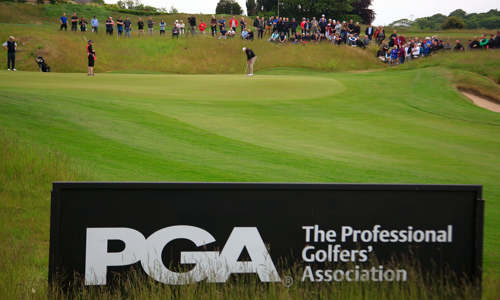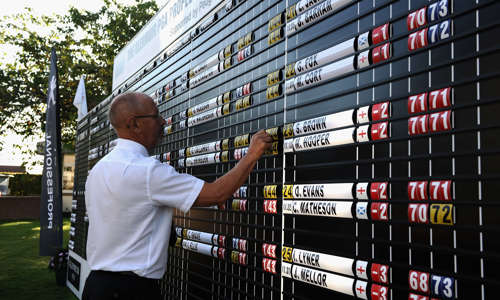The Woburn Head Professional recently became our 64th Member to achieve Master status – in his case as a Coach. He shares his journey right the way back from his days as an Assistant Pro to the present day.
In recent years Dan Grieve has become one of the most recognisable, and welcome, faces to break down the mysteries of the short game. The Woburn Head Professional is now a best-selling author with ‘3 Releases: The Short Game System’ and he now has over half a million followers thanks to his uncomplicated and hugely insightful knowledge of the short game. Grieve was recently awarded Master status through PGA Excel, and here he explains the path that took him from an assistant at Selby in Yorkshire to becoming one of the best coaches in the world.
Tell us about becoming a Master Professional
I have always been a lifelong learner. I have always liked to study and keep on developing my learning.
I was very proud to join the PGA in 2000 and I gained Trainee of the Year honours. I’ve always wanted to reach the top, and I’ve seen a few other Pros get Master status like Luther Blacklock at Woburn and I thought it would be nice one day to do the same. I have always wanted to improve my designations and keep moving up the ladder and, now that I have become a PGA Master Professional, it just shows that you aren’t sitting back and that you are trying to improve all the time.
To have made a global impact, which the book and the videos have done now, is probably the key behind the Master status. It was a lovely reward and I was very honoured to have been just the 64th PGA Professional to have received it. People in and out of the industry know what Master means and I have received loads of messages saying it is fantastic. It is the highest accolade that you could receive.
You began as an Assistant Pro at Selby, what did you take from your time there?
I just loved being in the golf arena. I’ve always loved the game and so working in golf was fantastic. I actually enjoy being behind the counter and chatting golf to people all day long.
It taught me just how much people love the game and how important it is to them. You kind of get an idea when you are an amateur golfer but, when you are working in golf, you really get a first-hand view of that. Then it helps you in terms of how you are going to coach.
What was the plan when you began your PGA Training?
I probably always wanted to be a Head Professional somewhere, with a bit of shop and a bit of teaching, but I never saw myself as being a full-time coach. I joined Woburn in 2006 and it was a part-time shop role with teaching the rest of the time. I was self-employed with the teaching, and it was up to me how much I did, so I very quickly developed a full diary. Then I went full-time teaching in 2008 and I have never looked back.
How did you do your research?
I studied all the coaches but I didn’t want to just do what other coaches did. So I read and watched everything. I knew Pete Cowen from my Yorkshire days and I liked a lot of Pete’s stuff and I would look at a lot of the American coaches, but really I wanted to come up with my own concepts. It is very easy to copy what the others do but I wanted to develop my own style and be able to demonstrate all the shots. Although I had a decent short game I wouldn’t say that it was fantastic, so I spent a lot of time watching the greats on TV, watching Seve Ballesteros and Jose Maria Olazabal on video and seeing how they play those shots and then working on it myself. There were hours on my own with a wedge in my hand. This is really where most of my research was done.
My research was done pre-TrackMan and HackMotion and then they just confirmed that I was on the right track. I do see the short game as more of an art definitely, but the technology just helps you confirm what you are doing.
How key is that ability to be able to demonstrate a shot yourself?
It’s absolutely crucial. I would practise every single day and that practice has paid off. If you ask me to hit a 3-iron off the deck I’ve got no chance, but in the short game I can stand in front of anybody and I can usually hit the shot first time. Golfers learn visually. I can describe it and I can show them without the ball but, if I can show them what I want them to do with the ball, that is so powerful. It also earns a player’s respect and helps deliver the point that you are trying to make. Whether you are a PGA Pro or anyone, there is no reason why you can’t become the best short game player in the world.
None of us are going to be able to swing the club like Scottie Scheffler or hit the ball like him, but there is no reason why any of us can’t chip like him. It is not a physical gift.
How did you settle upon the very simple style of your online videos?
I could see a lot of growth that the pros were getting and when I looked at their content, it was all of them facing the camera with the whole quick tips thing. I thought, let’s just coach. It was really raw at the start, someone would stand there with a phone and there was no audio, and I would do what I was doing every day. The great thing about short game videos as opposed to long game is that people can actually see the ball, which I think is really important. The people can see the result.
The other thing is that the people watching can relate to the people I’m working with. They are golfers of all levels and abilities. If you see a 20-handicapper improving their chipping style a little bit, then you think why can’t I? I get dozens of emails every day from golfers all over the world saying they’ve been watching the videos and their handicaps have come tumbling down or they’ve got rid of the yips, which is just so rewarding. A lot of the time they can fix it themselves.
Why has your three releases method resonated so well?
Firstly, people like the number ‘three’. We look for patterns in our brain and three is the first pattern that we get to. Four is too many whereas three is a good number and it suits the short-game system as well. And everyone likes a system – if you have got a system, you can learn the inputs required to get the desired outputs.
The main goal of the book was to create golfers who can coach themselves. There are lots of check lists: if you do this, this and this you will get this. A lot of short game coaching was too vague and people couldn’t really understand it. I wanted to create absolute clarity.
Your golfing IQ is equally as important as the technique because you have to be able to read the lie. You have to be able to understand where the pin is, where the slope is, what the green conditions are, what the lie is doing and you match your technique to the lie – and then you can play the shot well. I hope that the book is creating clarity that if you play a low shot you set up like this, and if you play a high shot you set up like this. And make sure that the lie allows it. The clarity is probably a big reason why it is a success. I went over the whole book again and again to make sure it is an easy read. I kept trying to make it simpler each time I edited it and there are no words in there that try to make me sound intelligent. It is just very simple stuff.
How much tech do you use these days?
I use video a lot and that is obviously really powerful. I will use that every single day and every lesson I will do pieces to camera about what the player can go away and work on so it is all totally clear.
I use TrackMan when I am pitching so you can look at smash factor and how the ball is coming off the clubface as well as getting a few numbers in terms of swing path, angle of attack, spin rate and launch angle.
Around the greens, if I’m using it, it is only because the person really wants to. Personally, around the greens I think using tech isn’t the way to go, it gets you away from the feel and artistic side of things. It gets you too wrapped up in the process and trying to get perfect numbers rather than trying to get the right shot. So I would really only use it from 40 to 100 yards.
Is the short game becoming more important in golf clubs these days?
I have definitely seen a trend with more clubs building specialist short-game areas and Woburn have helped to lead the way on that with our Tavistock Short Game Area. I also get all sorts of people coming to the short-game school telling me they have no facilities or a tiny little green which usually is poorly maintained and that there is no sand in the bunker and so on. I do think it can improve a lot and I’m hoping that the short-game revolution can help.
I would like to see more short-game facilities at ranges as well, even if it is just an artificial area. If you create enough space, you can do it.




































